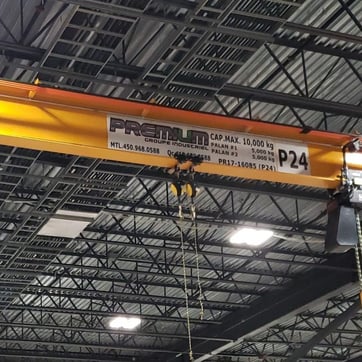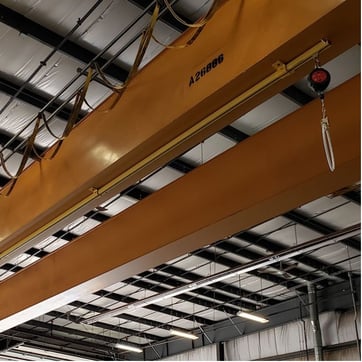-
PRODUCTSreturn
-
SERVICES AND PARTS
-
ABOUT US
Working at height: Can you use an overhead crane?
7:49
Heavy loads lifted by an overhead crane, dangerous machinery, working at height… The industrial environment seems to be the zone of all dangers! With the many accidents that have occurred in the manufacturing sector, safety measures, standards and audits make managing operations even more complex on a daily basis. For example, since the 2019 change in regulations on the maximum height allowed without protection, it’s no longer enough to measure the permitted height. Many companies have to deal with this situation on a daily basis.
Then, in this context, if a worker has to perform a task at height, how can he or she reach the location safely? How can you protect them from falling? Are there any regulations governing these methods? And if so, how do they work?
So many questions and headaches involved in… checking a noise, screwing a bolt or maybe even just… loading a trailer! Isn’t that a bit complicated for so little?
In this context, what about the use of an overhead crane when a worker is working at height? Over the past few years, I’ve noticed that the following questions are coming up more and more often in my exchanges with those who contact us :
- Can an overhead crane be used to lift a worker from a work platform (often called cage or basket)?
- Can an overhead crane structure be used to suspend a cable reel to protect a worker from a fall (i.e. as an anchor point for a fall arrest)?
These are excellent questions, and they’re perfectly legitimate! After all, factory ceilings are full of overhead cranes that can safely lift tons. So why not take advantage of this and use them for workers rather than complicating things!
Although these issues are still relatively new to the industry in Quebec, Premium has been looking into the matter. We have analyzed the standards in order to provide you with the most accurate information. This work has enabled us to develop comprehensive solutions to meet these needs, while reinforcing our expertise. In short, our aim is to become ever more specialized in lifting, so that you don’t have to!
So let’s make it simple! After reading this article, you’ll know whether or not you can lift a worker with an overhead crane. You’ll also know whether an overhead crane can be used as a fall arrest, and if so, what conditions must be met.
Rest assured, you don’t need to become an expert in safety laws and regulations to establish a safe working method. However, you will be able to act worry-free and with full confidence when one of your employees needs to work at height in your plant.
Let’s start with the first question : can an overhead crane be used to lift a worker?
Why is it forbidden to use an overhead crane to lift a worker?
It is indeed not permitted to lift a worker with an overhead crane. Why not?
Firstly, because the overhead crane was not designed for this use (article 260 of the RROHS). And even if steps were taken, no hoist manufacturer authorizes its products to lift a person.
So, what is the recommended solution? Use equipment designed for this purpose, such as lifts or aerial work platforms.
Although it’s not possible to use an overhead crane to lift a person, is it possible to attach a worker to the structure of an overhead crane as fall protection?
Mobile cranes : different regulations
Since it is possible to lift a person with a mobile crane (under certain conditions), confusion reigns on some construction sites. Some people think they can do the same thing with overhead cranes. But in fact, these 2 types of equipment are governed by completely different standards.

How can I safely use an overhead crane as a fall arrest?
This involves attaching the worker’s harness to a cable reel which is connected to an anchor point on the overhead crane structure, i.e. the crane frame. Such a system is generally referred to as a “fall arrest”. So, is it allowed to install a fall arrest on an overhead crane in this way?
Short answer : YES, but under certain conditions. Let’s take a look at the requirements and steps involved.

Mobile cart on the main girder

Rigid fall arrest system under the girder
Mandatory conditions for using an overhead crane as a fall arrest :
- An engineer must approve the use of the overhead crane for this purpose.
- An operating procedure must be documented
- The cable reel-unwinder must be installed on an anchor point designed for this purpose.
- Padlocking procedure : the overhead crane must be at energy 0 when the fall arrest is in use.
- If applicable, all adjacent cranes must be prevented from meeting the overhead crane in question, usually by means of a padlocking procedure (see other solutions below).
- Train workers to use the fall arrest system.
- The employer must set up a rescue procedure.
As we can see, it’s not easy to use an overhead crane as a fall arrest. So, are there any alternatives? If not, what solutions can simplify the process?
What is a 0-energy overhead crane?
Some might think that pressing the red stop-reset button (often called the emergency stop) is enough to bring an overhead crane to zero energy. In reality, that’s not sufficient.
Achieving zero energy means completely cutting off the power supply at the source, which can only be done through a lockout procedure.
Keeping the remote control on you does not replace a proper lockout procedure. Locking out the remote control does not bring the crane to a zero energy state.
Floor-level lockout devices provide effective safety without blocking other overhead cranes or disrupting operations. See the article : Maintenance zone: protect your workers while optimizing your operations!
Alternatives and solutions for a simple and safe fall arrest system!
Sometimes you just have to look at things differently to find a simpler solution. For example, instead of using an overhead crane, can you hang directly from the ceiling structure? Of course, the first step is to check that the joints can support a fall arrest. But if not, they can be reinforced. However, overhead cranes must be prevented from approaching the fall arrests while in use. What solutions are available for this?

Whether you’re hooked onto the overhead crane or the ceiling beams, solutions are available to prevent overhead cranes from approaching the fall arrests. For example, an isolation zone can be installed. What is it? It’s a system of conductor bars that electrically isolate the section of runway where the fall arrests are located, ensuring it is at 0 energy during use. It is also possible to install an interlock system. How does it work? When the harness of the worker who will be working at height is accessed, a system automatically deactivates the energy of the section to prevent adjacent overhead cranes from reaching the work area. This ensures the safety of the worker using a fall arrest in an area with overhead cranes.
Some companies specialize in fall arrest systems, beam reinforcement and interlock systems (for example, see “Worker safety: Fall arrest systems near overhead cranes“).
Safety: an important issue in the world of lifting!
As we have seen, the use of an overhead crane to lift a worker is prohibited. However, the use of an overhead crane structure as an anchor point for a fall arrest system may be possible under very strict conditions. In all cases, put your workers’ safety first! Workers’ lives and health are far too important to improvise! And when in doubt, consult a lifting specialist who is familiar with current standards. He or she will certainly be able to suggest solutions adapted to your needs, as there are many technologies available today for lifting.
Where to start?
Want to keep your workers safe when working at height, but wondering where to start? Here are 3 fall arrest installation situations we can help you with :
- To install a fall arrest as part of a new overhead crane project or manufactured by Premium, contact your lifting specialist. For example, you can fill in the form at the bottom of this page, and a representative will be happy to propose safe solutions.
- When installing a fall arrest on equipment not manufactured by Premium, we recommend that you first consult an engineer, as this is the first step. We can refer you to a partner if required. Simply specify this by filling in the request form at the bottom of the page.
- To install a fall arrest on a building structure, please contact Premium Industrial Structures.
In the end, the solution is quite simple! Let your lifting specialist guide you in your safety choices when your overhead cranes are involved. Find a good partner who can advise you based on current standards and regulations.
Manager and partner at Premium Industrial Group
Learning Center
Whether you're an expert or know nothing about cranes, you'll find everything you need to know HERE.






